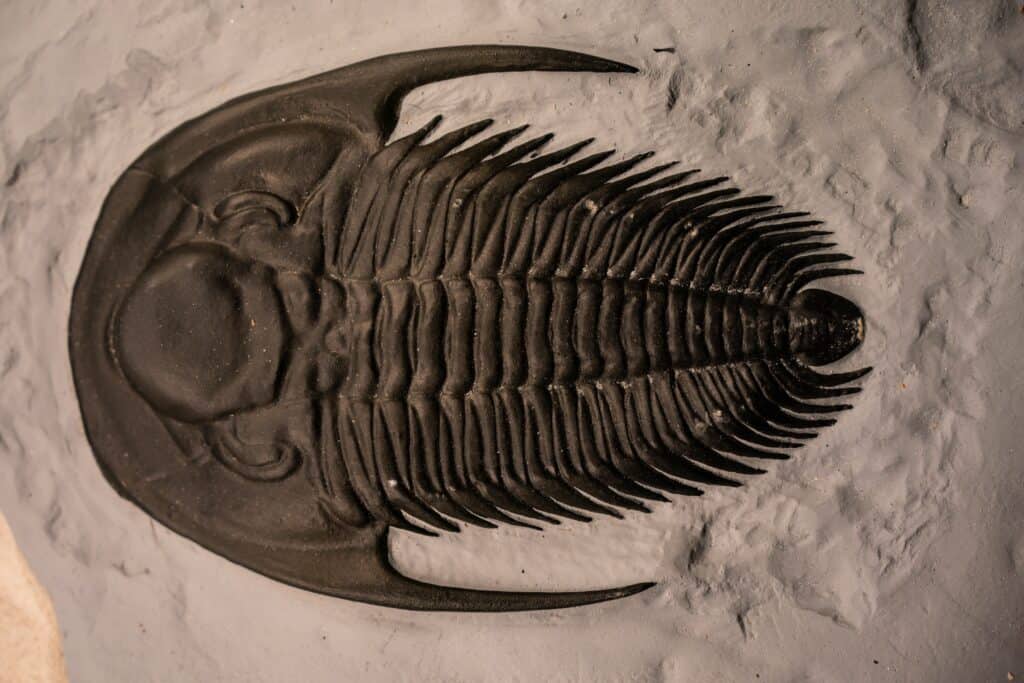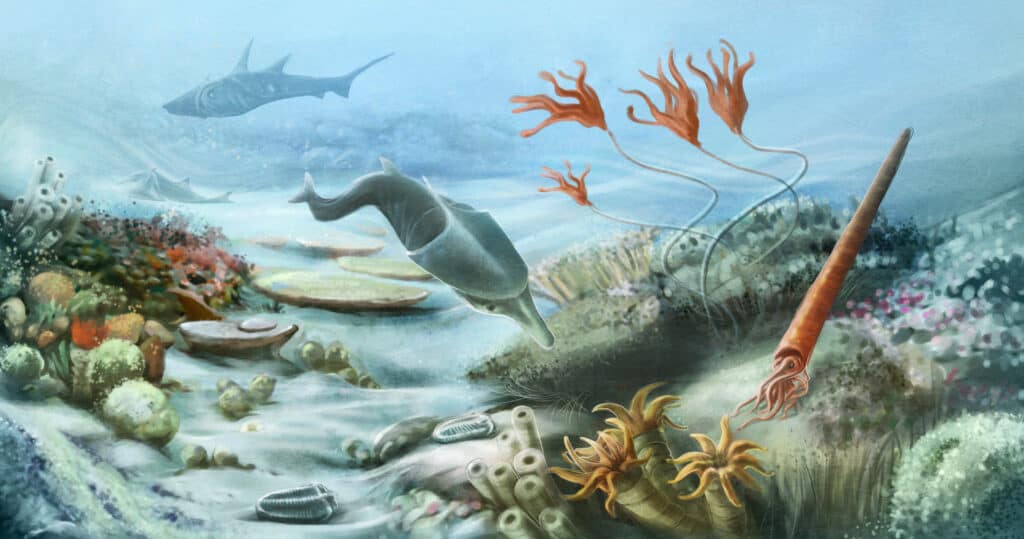About 443.8 million years ago, the planet was undergoing major changes. Global sea levels were rising dramatically due to melting ice. The advancing seas buried the continents and triggered major changes in climatic conditions.
Aside from the ongoing geological changes, the Silurian was also a significant period in the evolution of marine life. Coral reefs appeared for the first time, and many marine organisms, such as jawed fish, evolved. By the time the period ended about 419 million years ago, estuaries and terrestrial ecosystems were beginning to emerge and achieve stability.
Silurian Period—Timeline
On the geologic timescale, the Silurian Period is roughly 28 million years between the Ordovician and Devonian periods. It spanned from the end of the Ordovician about 444 million years ago to the beginning of the Devonian about 416 million years ago.
It is possible to trace back the rock layers marking the beginning and end of this period with relative precision. Still, we only know the precise dates within five to ten million years, as is the case with all recorded geologic periods.
The period is further divided into four subdivisions or epochs. The oldest subdivision is the Llandovery Epoch which began 438 million years ago, and this is followed by the Wenlock, Ludlow, and Přídolí epochs.
Major Events

Fossils trilobit Arctinurus boltoni from the Silurian period.
©MBLifestyle/Shutterstock.com
Each recorded geographical period has events peculiar to it. These events range from climatic conditions to animal life, plants, and others. The Silurian Period’s significant events are discussed below:
Earth’s Supercontinent and a Chain of Smaller Continents
At the start of the Silurian Period, most of the planet’s land mass aggregated to form a supercontinent known as Gondwana. This massive landmass had drifted to cover most of the equator and southern hemisphere. Consequently, the northern half of the planet was covered almost entirely by a continuous sea interspersed by two small continents—Laurentia and Baltica. A third continent, Avalonia, had also broken off from Gondwana and was drifting away.
Throughout the Silurian, Avalonia drifted northward towards the equator. At the same time, the other two northern continents began to move downward as well. The three continents eventually collided to form a continuous landmass known as Euramerica.
Mountain-Building Events
During the Silurian, there was no significant volcanic activity. Instead, the period saw major orogenic (mountain-building) occurrences in eastern North America and northwestern Europe, which led to the development of mountain chains in those regions. This geological event is the Caledonian orogeny. The collision of the three microcontinents of the Silurian gave rise to the hills and mountains seen in present-day Scotland, Ireland, Wales, and the northern Appalachians. The mountains of Sweden and Norway are also aftermaths of this event. In other regions, light sedimentation occurred throughout the Baltic region.
Even though there were no significant tectonic activities in the Silurian, major continental changes still exist. These changes laid the groundwork for the formation of terrestrial ecosystems during subsequent geologic periods.
Melting of the Glaciers
In the geologic periods preceding the Silurian, massive glacier blocks were formed due to plunging global temperatures. In contrast, the Silurian had stable warm temperatures. This ended the extreme glaciations of the Ordovician and the giant sheets of ice formed during this period began to melt. Because of this, the levels of the major seas rose substantially. The rising sea level favored the aquatic ecosystem with the formation of new, thriving marine habitats.
The Silurian Climate
The position of the continents relative to the global ocean heavily influenced the climate of the Silurian Period. The entire planet had a vast paleo-ocean in the northern hemisphere and land in the southern hemisphere.
It isn’t sure whether or not the average global sea and air temperature during the Silurian Period was more than 110 or 120 degrees Fahrenheit. The Silurian glaciers (leftover from the end of the preceding Ordovician Period) covered much of the planet. However, global temperatures began to rise towards the beginning of the Devonian.
Generally, the earth was in a long greenhouse phase with high carbon dioxide levels during much of the Silurian. The implication was that the earth’s temperature helped maintain a stable climate in contrast to the erratic climatic conditions experienced in the previous geologic periods. The glaciers receded gradually, and only the planet’s south pole had them. By the middle of the Silurian, they had almost disappeared completely. Despite the relative stability, warm air columns meant violent storms dominated the earth. Evidence of this is the presence of broken coquina shells from that period.
Silurian Period Plant Life
Rising global sea levels in the early part of the Silurian meant most of the evolutionary action was taking place in the water rather than on land. However, the Silurian also saw the evolution of an extensive terrestrial biota.
The planet’s first forest appeared during this period. They were made up of mosses rather than trees and were formed along the sparse lakes and streams of the Silurian. Lichens were the first photosynthetic plants to grow on rocky coasts of the Silurian. With time, bryophytes such as mosses, hornworts, and liverworts appeared. All of these began in the Ordovician, extending into the Silurian. These miniature forests also paved the way for the evolution of terrestrial life later in the period.
The Silurian also saw the first conclusive evidence of vascular terrestrial plants—Cooksonia and Baragwanathia. These Silurian Period plants were short-statured and had well-developed transport mechanisms for water and nutrients. Vascular plants like this date back to the Silurian period’s second half.
Silurian Period Animal Life

Prehistoric fish of the Silurian Period could pursue and defend themselves against a wider variety of prey brought about by the development of jaws and teeth.
©Alena Hovorkova/Shutterstock.com
Paleontologists discovered direct fossil evidence of the first land-dwelling millipedes and scorpions during the Silurian Period. Primitive terrestrial arthropods were undoubtedly present during this period and are the significant highlights of fossil finds. On the other hand, substantial terrestrial animals would evolve later as vertebrates progressively figured out how to inhabit the dry ground.
Silurian rocks are often characterized by an interesting assortment of terrestrial fossils showing the first land-faring organisms of the plant. The Ordovician preceded the Silurian, and scientists believe marine animals (notably arthropods) ventured on land for the first time. However, fossils of terrestrial animals from that period are poorly preserved.
The Silurian sea was where most of the biological actions took place. The crinoids and brachiopods evolved significantly and grew in number during this period. The oldest known fossils of coral reefs are also from this geologic time.
The evolution of jawed fish such as Birkenia and Andreolepis is another significant biological event attributed to the Silurian Period. This was a major step forward for vertebrate animals. Prehistoric fish of the Silurian Period could pursue and defend themselves against a wider variety of prey brought about by the development of jaws and teeth. This pre-predator competition was a major driving force in the evolution of subsequent vertebrates. As predators evolved, their prey also developed a wide range of defences to survive.
Furthermore, Psarepolis, the first lobe-finned fish ever discovered, lived during the Silurian and is considered the ancestor of the pioneering tetrapods that appeared in the Devonian.
Up Next
- Devonian Period: Facts, Information, and Timeline
- Ordovician Period: Facts, Information, and Timeline
- Permian Period: Facts, Information, and Timeline
The photo featured at the top of this post is © MBLifestyle/Shutterstock.com
Sources
- Vedantu, Available here: https://www.vedantu.com/geography/silurian-period
- Natural History Museum, Available here: https://natmus.humboldt.edu/exhibits/life-through-time/visual-timeline/silurian-period
- Live Science, Available here: https://www.livescience.com/43514-silurian-period.html
- UCMP, Available here: https://ucmp.berkeley.edu/silurian/silurian.php
Thank you for reading! Have some feedback for us? Contact the AZ Animals editorial team.






